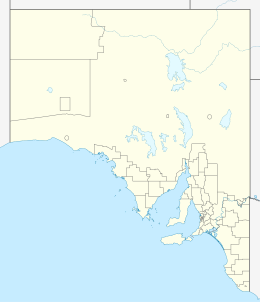Thistle Island
| Geography | |
|---|---|
| Location | Spencer Gulf |
| Coordinates | 34°59′56″S 136°08′30″E / 34.998824°S 136.141641°E |
| Administration | |
Australia | |
Thistle Island is in the Spencer Gulf, South Australia, some 200 km west of Adelaide, and northwest of the Gambier Islands. The city of Port Lincoln lies to the northwest of the island. Between them, the Gambier Islands and Thistle form a chain across the mouth of the gulf between the southern tips of the Yorke and Eyre Peninsulas.[1] As of 2014 the Royal Australian Navy operated an acoustic range in the waters west of Thistle Island, with a small control facility being located on the island itself.[2]
History
The island was named by British explorer Matthew Flinders in 1802, after a terrible accident in which a cutter that was mastered by John Thistle and carrying 7 other men, overturned in choppy seas while returning from the mainland to the ship. Despite frantic searching by the ships crew, the bodies of the men were never found. Flinders also named several smaller islands in the area after the lost crew.[3]
Evidence of a failed settlement was noted by early whalers. It was speculated that the remains, which "the ruins of some cottages with signs of regular order in their arrangement and a cleared promenade between them, all the loose limestone for a distance of a bout 100 yards having been thrown on each side of a broad path." It was speculated that the ruins may have been built by survivors of the La Perouse expedition of 1788.[4]
A small community of sealers, their Aboriginal "wives" and children were living on the island by 1832. They are thought to have had their camp on the shore of Waterhouse Bay.[5]
The South Australian Company established a shore-based bay whaling station at Whalers Bay in 1838. A team of experienced whalers were brought from Tasmania with H.B.T. McFarlane in charge as headsman. The operation had limited success during the 1838 season and none at all in the 1839 season. It was concluded the location was too far from the migration route of the southern right whale and the site was abandoned.[6]
The historic Whalers Bay Whaling Site and Thistle Island Sealing Site are both listed on the South Australian Heritage Register.[7][8]
Flora & Fauna
Visitors to Thistle Island in 1877 found neither little penguins nor Australian sea lions, but did find numbers of paper nautilus shells on the island's inner beach.[9] Visitors to Whaler's Bay heard the calls of "hundreds" of little penguins from their anchorage there in 1904.[10] In 1932, J. T. Mortlock gave an account from Whaler's Bay of the "mournful symphony of the curlews and penguins in the nearby cliffs".[11]
An account of a visit in 1928 wrote: "On Black Rock, at the north end of Thistle Island, we disturbed a large colony of seals, which rapidly scrambled into the water as the yacht passed by. Shags were plentiful. Many types of sea fowl were observed, including gannet, arctic skua, mollyhawk and stormy petrel."[12]
Former Lord Mayor of Adelaide A. S. Hawker held a fishing record for a 47 lb tuna that he caught off Thistle Island in the late 1930s.[13]
Little penguin breeding sites were noted in a 1996 survey of South Australia's offshore islands,[14] though the colony may have been recorded on Albatross Island off the island's southern tip.
References
- ^ Collins concise atlas of the world (3rd ed.) (1993). London: HarperCollins.
- ^ Morris, Alex (2014). "Submarine Acoustic Analysis Cell goes to SAAR" (PDF). The Trade (2): 15.
- ^ Matthew Flinders, A voyage to Terra Australis (Chapter 6). Retrieved 25 January 2019
- ^ "WHERE ADELAIDE MIGHT HAVE BEEN". Register (Adelaide, SA : 1901 - 1929). 16 February 1904. p. 6. Retrieved 12 July 2020.
- ^ Kostoglou & McCarthy, p.57.
- ^ Kostoglou, Parry; McCarthy, Justin (1991). Whaling and sealing sites in South Australia (First ed.). Fremantle: Australian Institute for Maritime Archaeology. p. 24.
- ^ "Whalers Bay Whaling Site, Thistle Island". South Australian Heritage Register. Department of Environment, Water and Natural Resources. Retrieved 12 February 2016.
- ^ "Thistle Island Sealing Site (designated place of archaeological significance)". South Australian Heritage Register. Department of Environment, Water and Natural Resources. Retrieved 12 February 2016.
- ^ "NATURALIST". Sydney Mail and New South Wales Advertiser (NSW : 1871 - 1912). 16 June 1877. p. 3. Retrieved 9 July 2020.
- ^ "WHERE ADELAIDE MIGHT HAVE BEEN". Register (Adelaide, SA : 1901 - 1929). 16 February 1904. p. 6. Retrieved 12 July 2020.
- ^ "Out among the People". Chronicle (Adelaide, SA : 1895 - 1954). 8 September 1932. p. 63. Retrieved 12 July 2020.
- ^ "ISLANDS OF REMEMBRANCE". Register (Adelaide, SA : 1901 - 1929). 21 January 1928. p. 12. Retrieved 12 July 2020.
- ^ "Out among the People". Chronicle (Adelaide, SA : 1895 - 1954). 19 June 1941. p. 46. Retrieved 12 July 2020.
- ^ Robinson, Tony; Canty, Peter; Mooney, Trish; Rudduck, Penny (1996). South Australia's Offshore Islands (PDF). South Australia: Resource Management Branch, Department of Environment and Natural Resources, South Australia. ISBN 0 644 35011 3.

